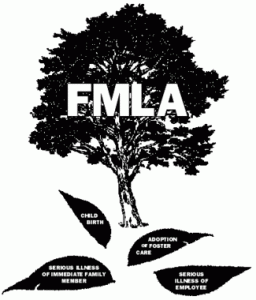The Family and Medical Leave Act of 1993 (the “FMLA”) provides much-needed flexibility for employees who need time off of work in order to care for personal or familial needs.[1] Title I[2] of the FMLA allows eligible employees[3] working for a covered employer[4] up to 12 weeks of unpaid leave to care for a “spouse, or a son, daughter, or parent, of the employee, if such spouse, son, daughter, or parent has a serious health condition,” among other reasons.[5]
Up until this summer, however, the federal Defense of Marriage Act (“DOMA”) prevented many same-sex couples from using FMLA benefits enjoyed by their heterosexual counterparts. In particular, an otherwise eligible employee in a same-sex couple legally married and living in a state that allowed or recognized same-sex marriage could not avail himself or herself of the FMLA’s 12 weeks of unpaid leave to care for his or her same-sex spouse. This is because under DOMA, the federal government was prohibited from recognizing any marriage that was not between one man and one woman.[6]
On June 26, 2013, the Supreme Court in United States v. Windsor declared as unconstitutional the provisions in DOMA that denied federal benefits to state-sanctioned, legally married same-sex couples.[7] In light of the Supreme Court’s decision, the Department of Labor updated its Fact Sheet #28F’s definition of “spouse” to make include same-sex couples as consistent with the Windsor decision. The Fact Sheet now defines “spouse” as “a husband or wife as defined or recognized under state law for purposes of marriage in a state where the employee resides, including ‘common law’ marriage and same-sex marriage.”[8] By redefining “spouse,” eligible homosexual employees who are legally married and who reside in those states (and jurisdictions) that recognize same-sex marriages—currently California,[9] Connecticut, Delaware, Iowa, Maine, Maryland, Massachusetts, Minnesota, New Hampshire, New York, Rhode Island, Vermont, Washington, and the District of Columbia—may now be able to avail themselves of FMLA protections for a spouse with a serious health condition.[10]
The Windsor opinion also expanded coverage for those persons covered by Title II of the FMLA, i.e., most employees of the federal government. [11] The Office of Personnel Management, the entity that administers Title II of the FMLA, noted on its website that the term “spouse” now includes same-sex couples who are legally married regardless of whether or not they currently reside in a state that recognizes same-sex marriage. So, if a same-sex couple gets married in Maryland, a state that has legalized same-sex marriages, and resides in Virginia, a state that neither permits same-sex marriages nor recognizes same-sex marriages from other states, that couple may still be able to avail themselves of FMLA benefits if they are employees of the federal government and otherwise qualify under Title II.[12]
What practical effect does this have on you?
If you are an employee in a legally recognized same-sex marriage covered by either Title I or Title II of the FMLA, these changes mean that you may now be able to seek up to 12 weeks of FMLA protected leave to care for your same-sex spouse who has a serious health condition.
If you are an employer covered by Title I of the FMLA and operating in one of the states (or jurisdictions) listed above, or employers with employees living in those states, you should quickly review their current coverage policies and update them if necessary in order to stay in compliance with this evolving area of law. Likewise, federal government employers covered by Title II of the FMLA must also adjust their leave policies, educate Human Resources staff, and advise employees of the expanded coverage.
Other useful discussions on this topic include:
- Modern Families and Worker Protections
[1] 29 U.S.C. §§ 2601-2654 (2012).
[2] The FMLA has two titles: Title I and Title II. As a general rule, Title I covers employees in the private sector, state and local government employees, along with particular categories of federal government employees. Title I is codified at 29 U.S.C. § 2601 et seq., and accompanying regulations found at 29 C.F.R. Part 825. Title II covers the vast majority of the federal government employees covered by the FMLA’s protections. Title II is codified at 5 U.S.C. § 6301 et seq., and accompanying regulations found at 5 C.F.R. Part 630.
[3] 29 U.S.C. § 2611(2); 29 C.F.R. §§ 825.102, 825.104, 825.110.
[4] 29 U.S.C. §§ 2611(2)(B); 29 C.F.R. §§ 825.102, 825.104-825.109.
[5] 29 U.S.C. § 2612. The other categories are: “for the birth of a son or daughter of the employee and in order to care for such son or daughter”; “the placement of a son or daughter with the employee for adoption or foster care”; “to care for the spouse, or a son, daughter, or parent, of the employee, if such spouse, son, daughter, or parent has a serious health condition”; and “any qualifying exigency (as the Secretary shall, by regulation, determine) arising out of the fact that the spouse, or a son, daughter, or parent of the employee is on covered active duty (or has been notified of an impending call or order to covered active duty) in the Armed Forces.”
[6] 28 U.S.C. § 1738C, overruled by United States v. Windsor, 570 U.S. —, 133 S. Ct. 2675 (2013).
[7] Windsor, slip op. at 13-26, 570 U.S. —, 133 S. Ct. 2675 (2013).
[8] U.S. Department of Labor, Wage and Hour Division, Fact Sheet #28F: Qualifying Reasons for Leave under the Family and Medical Leave Act, (Aug. 2013), http://www.dol.gov/whd/regs/compliance/whdfs28f.pdf. Note, however, that the Department of Labor ’s regulations for the FMLA do not refer to same-sex marriage at all. Instead “spouse” is defined as “a husband or wife as defined or recognized under State law for purposes of marriage in the State where the employee resides, including common law marriage in States where it is recognized.” Hopefully, the Department of Labor will revise its regulations to clarify the inclusion of same-sex marriages in those jurisdictions where it is allowed.
[9] The legality of same-sex marriage in California will undoubtedly be under attack again in light of the Supreme Court’s decision in Hollingsworth v. Perry. 570 U.S. —, 133 S. Ct. 2652 (2013).
[10] The FMLA’s regulations extensively define what constitutes as a “serious health condition” in order to qualify for FMLA leave. 29 C.F.R. §§ 825.113-825.119.
[11] 29 C.F.R. § 825.102 (providing a nonexclusive list of those persons covered by Title II of the FMLA); 5 C.F.R. § 630.1201(b)(2).
[12] Office of Personnel Management, Pay & Leave, Fact Sheet: Family and Medical Leave.



